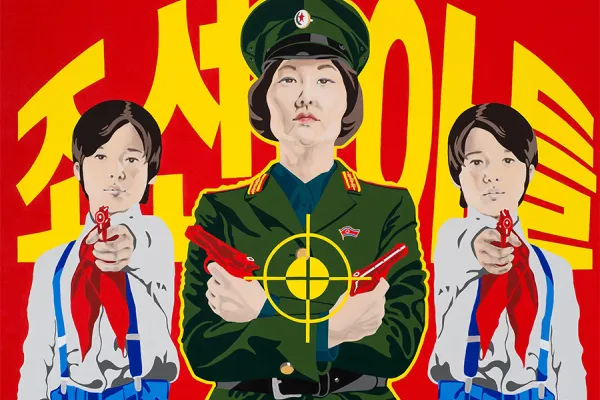Bodily Images Reveal Varied Cultures of Modern East Asia
Smith Arts

Published February 14, 2018
A new exhibition at the Smith College Museum of Art explores what artistic representations of the body reflect about East Asian cultures and history from the 19th century to the present.
On view through August, 体 Modern Images of the Body from East Asia, features artworks drawn mainly from the SCMA’s collection that evoke the region’s changing identities, socio-political realities and artistic movements.
The Chinese character for “body” in the title captures the multifaceted inspiration for the exhibition, says Yao Wu, Jane Chace Carroll Curator of Asian Art and organizing curator of the display.
“There are multiple layers of the word, which is shared in Chinese, Japanese and Korean languages,” she says. “It can refer to body, as in your physical being, but also to figurative or abstract principles, such as how a nation or society is organized.”
The exhibition features artworks that span issues of the personal and the collective in a variety of East Asian cultures, and cover almost every medium, including ink and oil paintings, drawings, prints, photographs, ceramics, sculpture, textile and video.
An underlying aim of the display is to challenge limited notions about Asian art and culture
The artworks are organized in four sections that track the overall exhibition theme: Bodies of the Other, Bodies at War, Bodies in the Plural and Bodies in Transformation. A timeline of modern East Asian history provides a broader framework for each piece, and a visitor station at the end of the exhibition invites museumgoers to offer comments.
An underlying aim of the display is to challenge limited notions about Asian art and culture, Wu says.
“Sometimes, categorization of art reveals our biases,” she notes. “That is why there are non-Asian and Asian-American artists included in the exhibition, and why there are also bodily images of Westerners made in East Asia.”
Anthropology major Maia Erslev ’18—who helped research and design the exhibition—says a 19th-century European photograph of Japanese women in traditional dress is her favorite piece.
“It’s an interesting representation of cross-cultural exchange,” Erslev says, noting that the women in the photo are adopting a Western pose known as the Grecian Bend.
Tara Sacerdote ’18 and Julia Xu ’19 also contributed to the development of the exhibition.
Among the other works currently on view in 体 Modern Images of the Body from East Asia:
- Native Types, a group of hand-colored albumen photographs from an album published in Japan in 1868 by Italian-born British artist Felice Beato;
- Lhasa Dance Steps, a 1980 ink painting by Chinese artist Ye Quianyu;
- Internet Dweller, a 1997 sculpture by Korean-born artist Nam June Paik;
- Sons of Joseon: Squirt Water Not Bullets!, a 2013 work by South Korean-born Mina Cheon that depicts her artistic alter ego, Kim Il Soon.
Cheon will visit Smith next month as part of a series of exhibition-related public programs, including a performance at the museum Friday, March 2, at 4:30 p.m., and a Five College faculty symposium Saturday, March 3, from 10 a.m. to 3:30 p.m. in Graham Auditorium, Hillyer Hall. Cheon will also give Smith’s annual Miller Lecture in Art History at 4 p.m. Saturday, March 3, in Weinstein Auditorium, Wright Hall.
More information is available online.
体 Modern Images of the Body from East Asia is funded by the Nolen Endowed Fund for Asian Art Initiatives at the Smith College Museum of Art.
Sons of Joseon: Squirt Water Not Bullets!, 2013, Mina Cheon